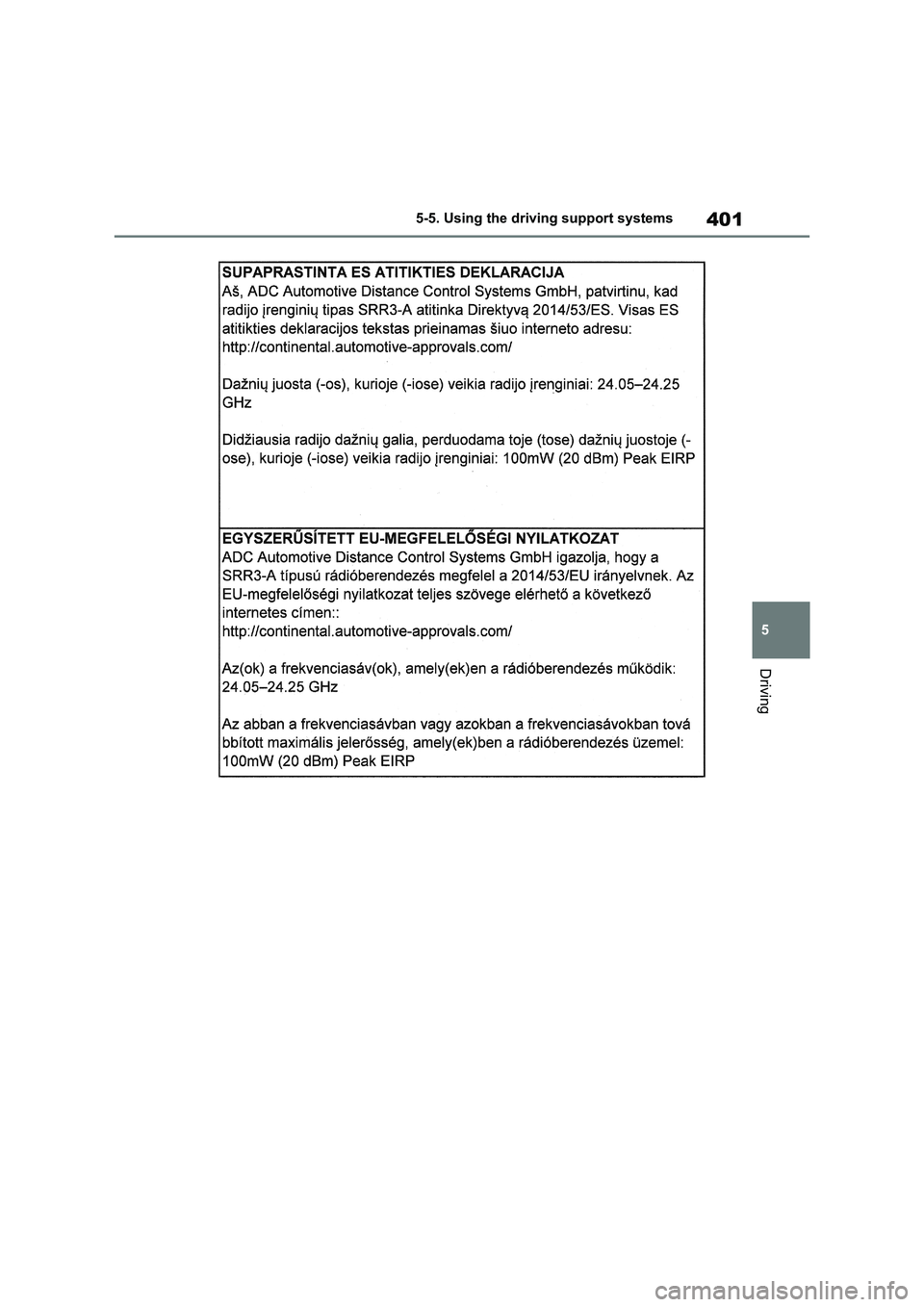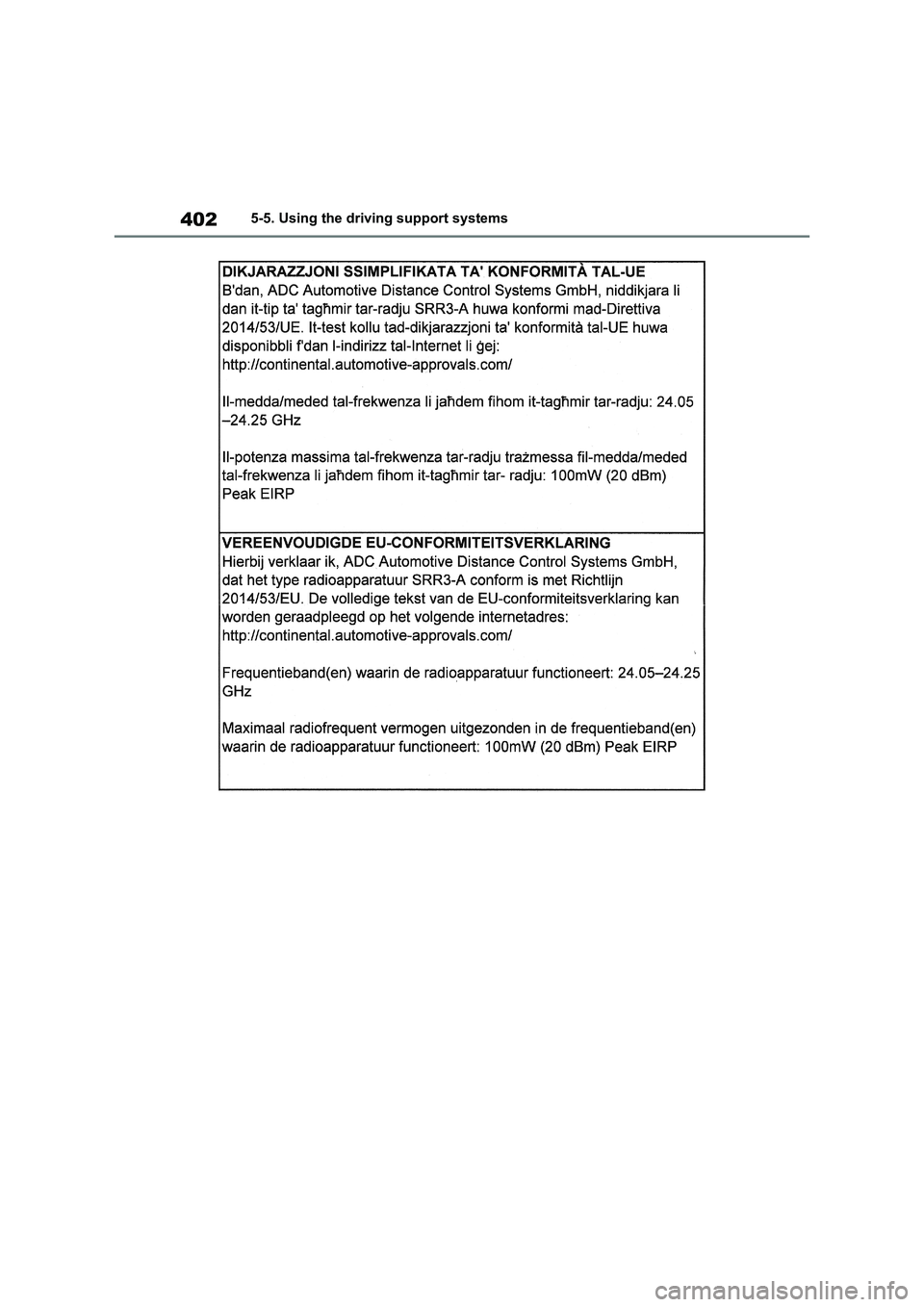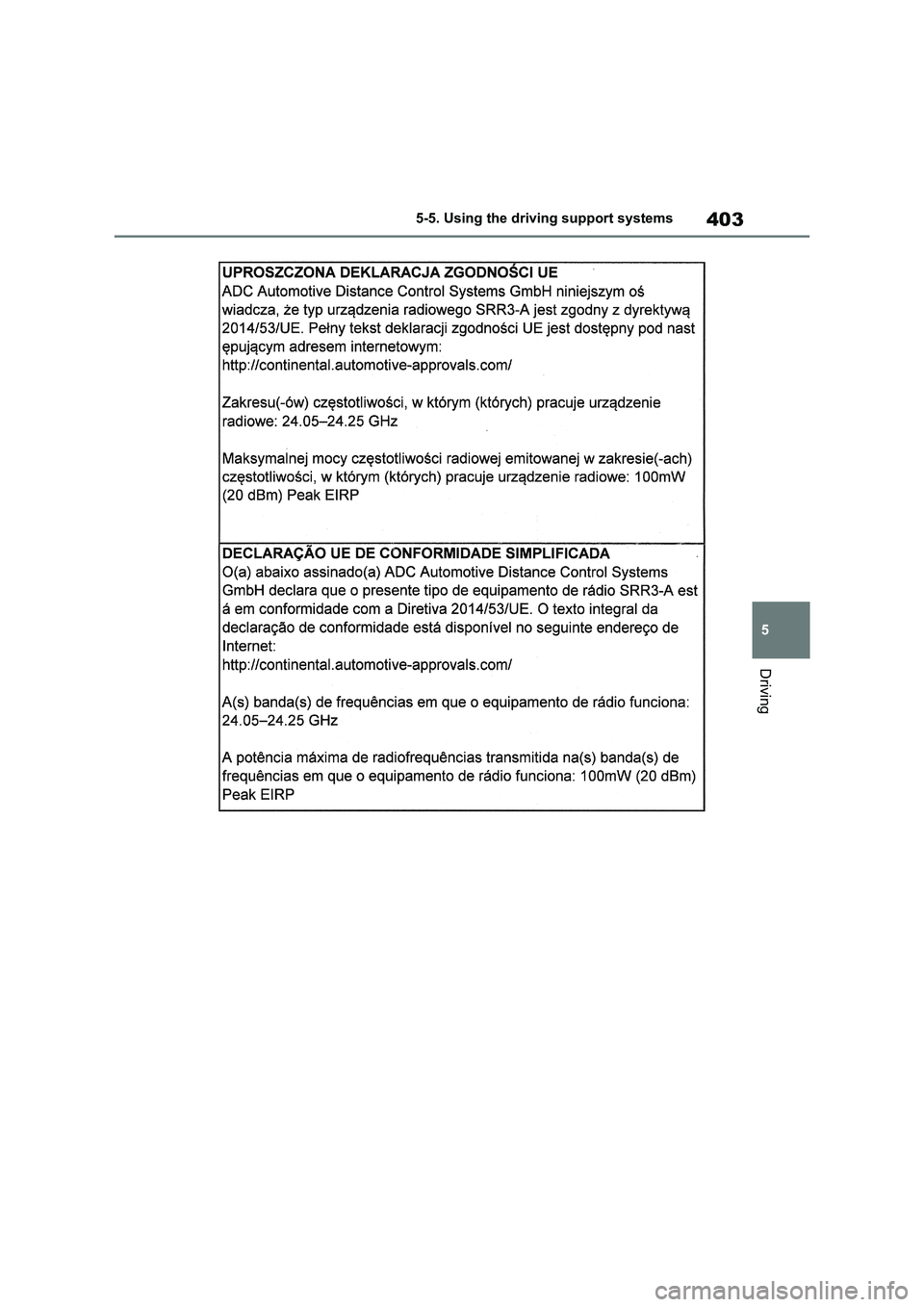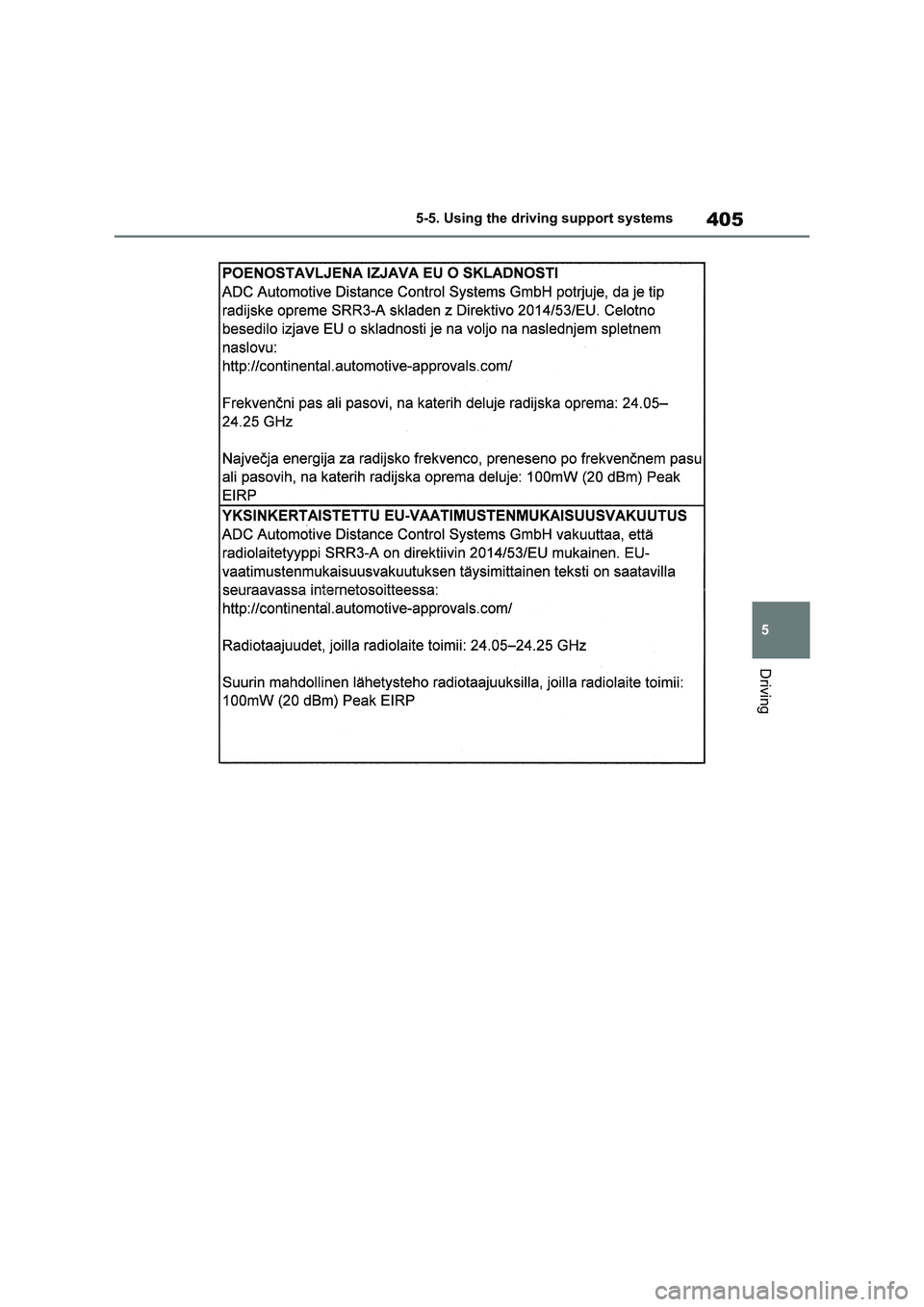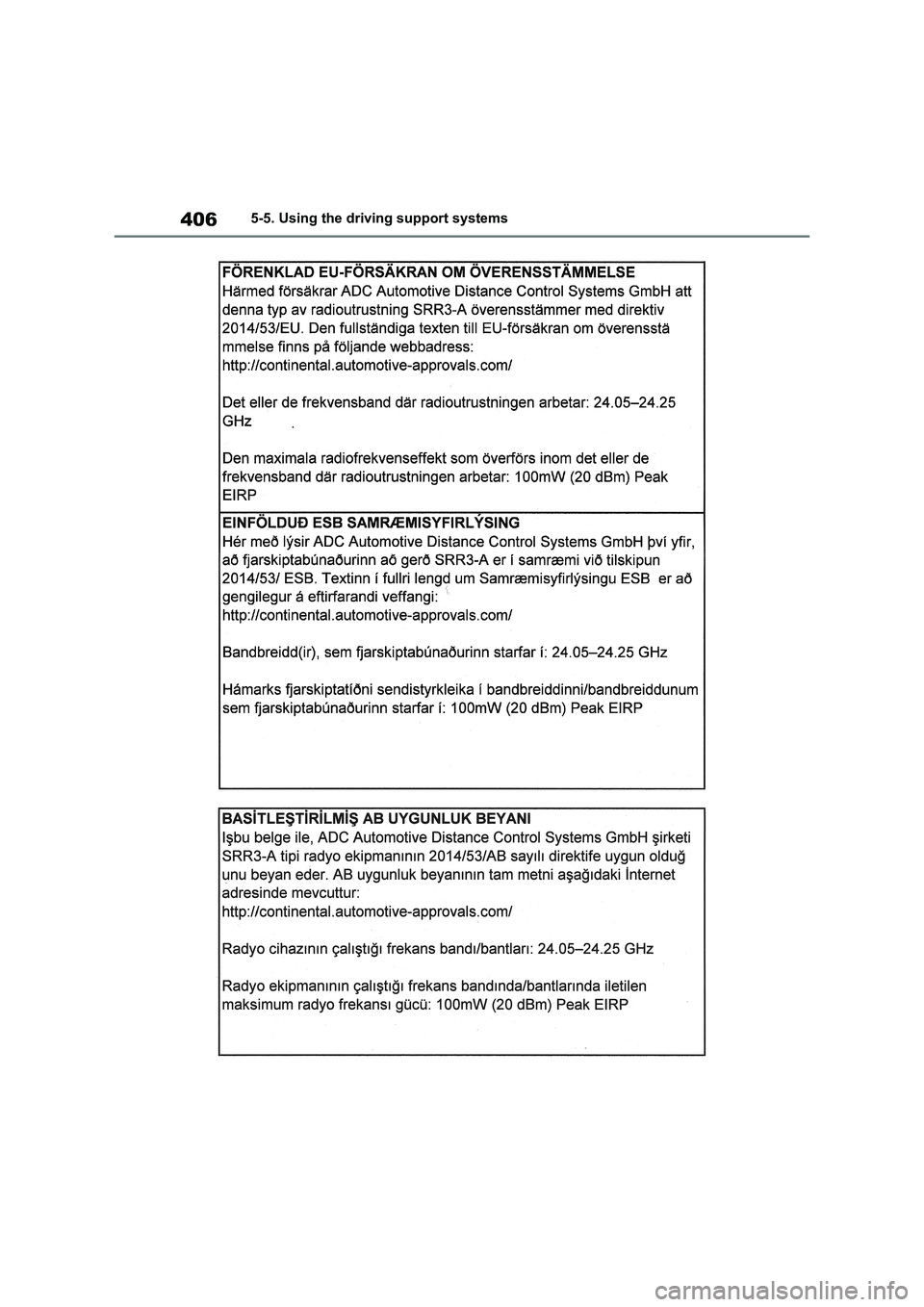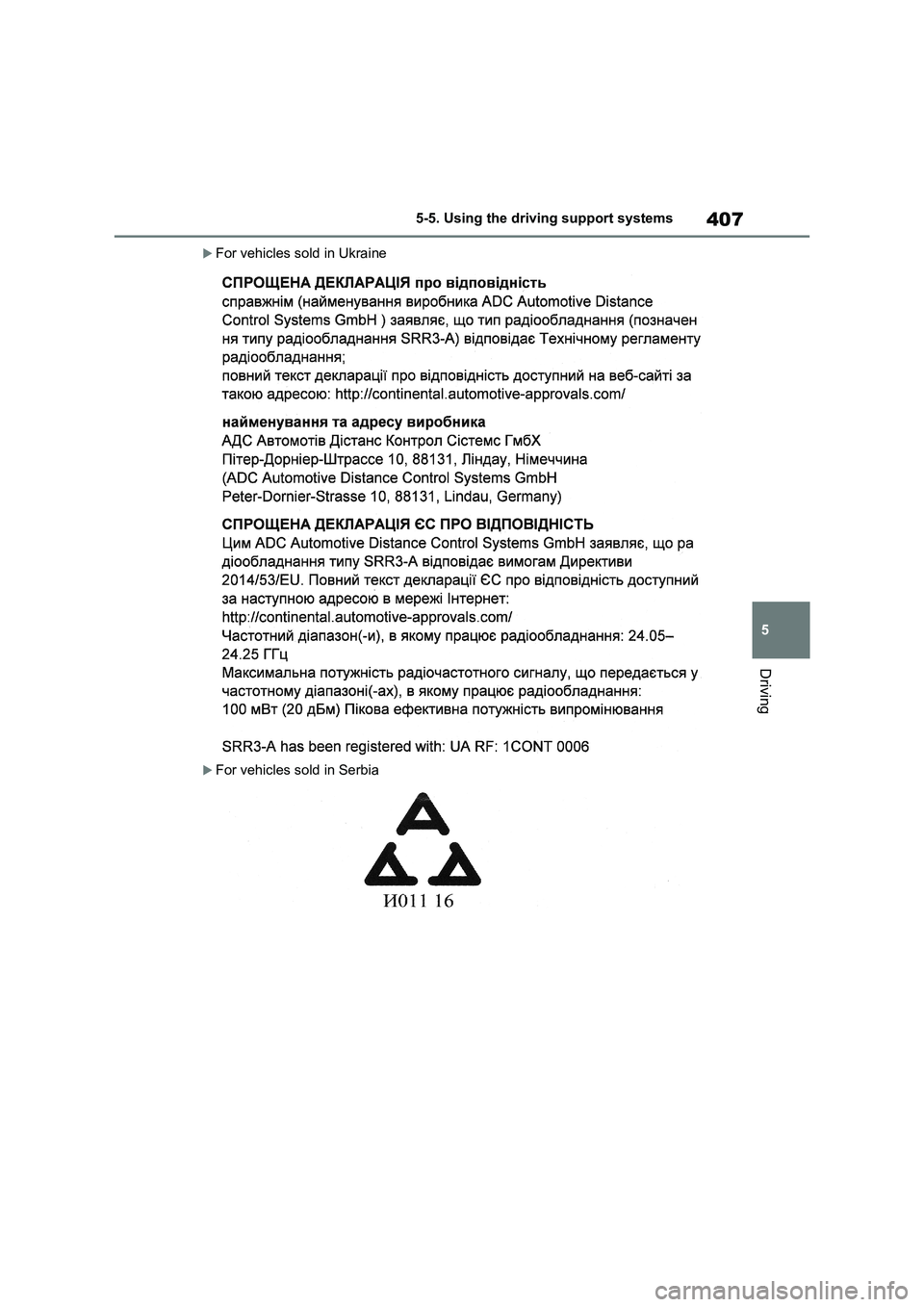TOYOTA VERSO S 2011 Owners Manual
VERSO S 2011
TOYOTA
TOYOTA
https://www.carmanualsonline.info/img/14/49148/w960_49148-0.png
TOYOTA VERSO S 2011 Owners Manual
Trending: fuel tank capacity, coolant temperature, headlight bulb, child restraint, spare tire location, low oil pressure, wheel alignment
Page 401 of 664
401
5 5-5. Using the driving support systems
Driving
Page 402 of 664
4025-5. Using the driving support systems
Page 403 of 664
403
5 5-5. Using the driving support systems
Driving
Page 404 of 664
4045-5. Using the driving support systems
Page 405 of 664
405
5 5-5. Using the driving support systems
Driving
Page 406 of 664
4065-5. Using the driving support systems
Page 407 of 664
407
5 5-5. Using the driving support systems
Driving
For vehicles sold in Ukraine
For vehicles sold in Serbia
Page 408 of 664
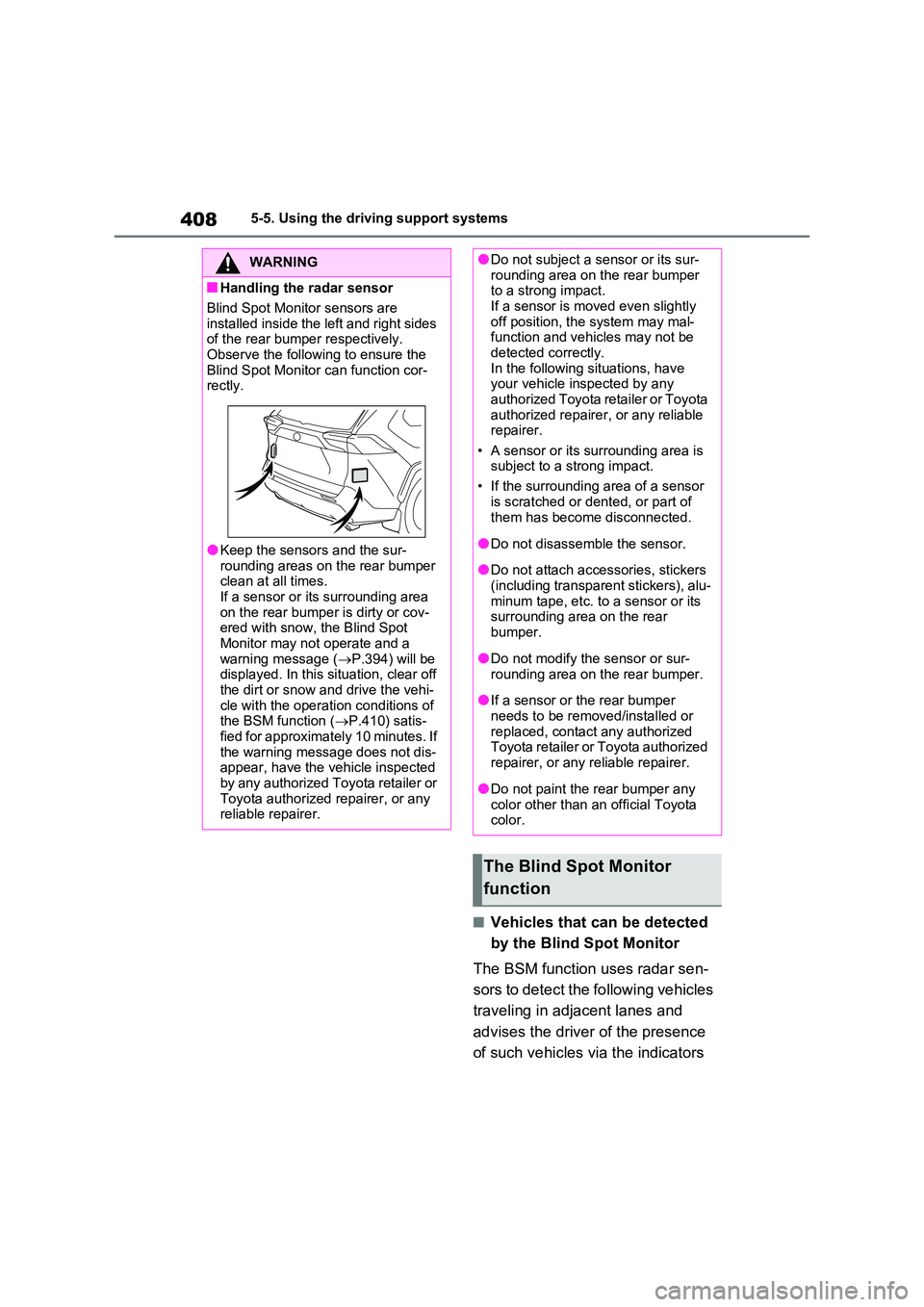
4085-5. Using the driving support systems
■Vehicles that can be detected
by the Blind Spot Monitor
The BSM function uses radar sen-
sors to detect the following vehicles
traveling in adjacent lanes and
advises the driver of the presence
of such vehicles via the indicators
WARNING
■Handling the radar sensor
Blind Spot Monitor sensors are
installed inside the left and right sides of the rear bumper respectively. Observe the following to ensure the
Blind Spot Monitor can function cor- rectly.
●Keep the sensors and the sur-rounding areas on the rear bumper clean at all times.
If a sensor or its surrounding area on the rear bumper is dirty or cov-ered with snow, the Blind Spot
Monitor may not operate and a warning message ( P.394) will be displayed. In this situation, clear off
the dirt or snow and drive the vehi- cle with the operation conditions of the BSM function ( P.410) satis-
fied for approximately 10 minutes. If the warning message does not dis-appear, have the vehicle inspected
by any authorized Toyota retailer or Toyota authorized repairer, or any reliable repairer.
●Do not subject a sensor or its sur-rounding area on the rear bumper to a strong impact.
If a sensor is moved even slightly off position, the system may mal-function and vehicles may not be
detected correctly. In the following situations, have your vehicle inspected by any
authorized Toyota retailer or Toyota authorized repairer, or any reliable repairer.
• A sensor or its surrounding area is subject to a strong impact.
• If the surrounding area of a sensor
is scratched or dented, or part of them has become disconnected.
●Do not disassemble the sensor.
●Do not attach accessories, stickers
(including transparent stickers), alu- minum tape, etc. to a sensor or its surrounding area on the rear
bumper.
●Do not modify the sensor or sur-
rounding area on the rear bumper.
●If a sensor or the rear bumper
needs to be removed/installed or replaced, contact any authorized Toyota retailer or Toyota authorized
repairer, or any reliable repairer.
●Do not paint the rear bumper any
color other than an official Toyota color.
The Blind Spot Monitor
function
Page 409 of 664
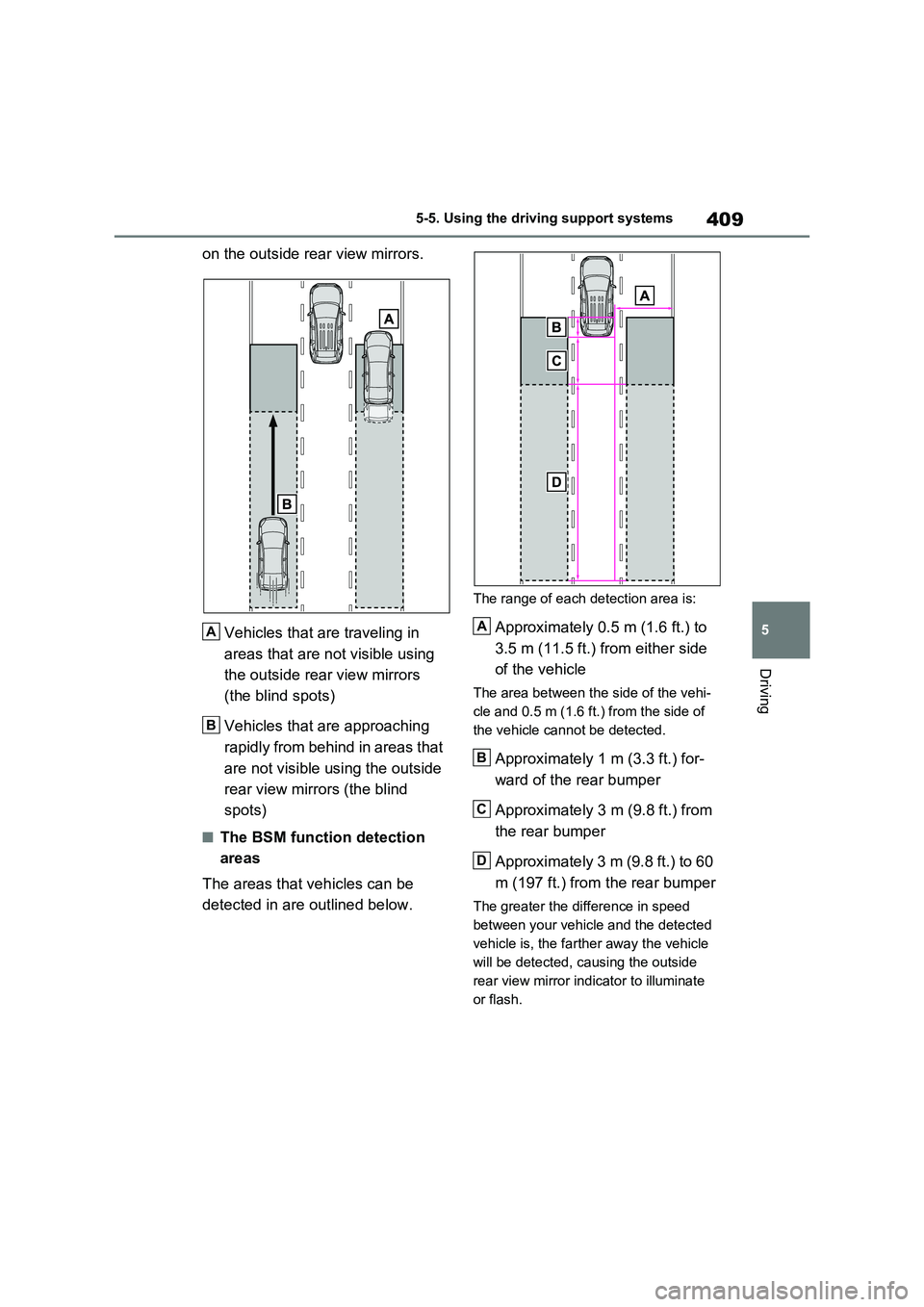
409
5
5-5. Using the driving support systems
Driving
on the outside rear view mirrors.
Vehicles that are traveling in
areas that are not visible using
the outside rear view mirrors
(the blind spots)
Vehicles that are approaching
rapidly from behind in areas that
are not visible using the outside
rear view mirrors (the blind
spots)
■The BSM function detection
areas
The areas that vehicles can be
detected in are outlined below.
The range of each detection area is:
Approximately 0.5 m (1.6 ft.) to
3.5 m (11.5 ft.) from either side
of the vehicle
The area between the side of the vehi-
cle and 0.5 m (1.6 ft.) from the side of
the vehicle cannot be detected.
Approximately 1 m (3.3 ft.) for-
ward of the rear bumper
Approximately 3 m (9.8 ft.) from
the rear bumper
Approximately 3 m (9.8 ft.) to 60
m (197 ft.) from the rear bumper
The greater the difference in speed
between your vehicle and the detected
vehicle is, the farther away the vehicle
will be detected, causing the outside
rear view mirror indicator to illuminate
or flash.
A
B
A
B
C
D
Page 410 of 664
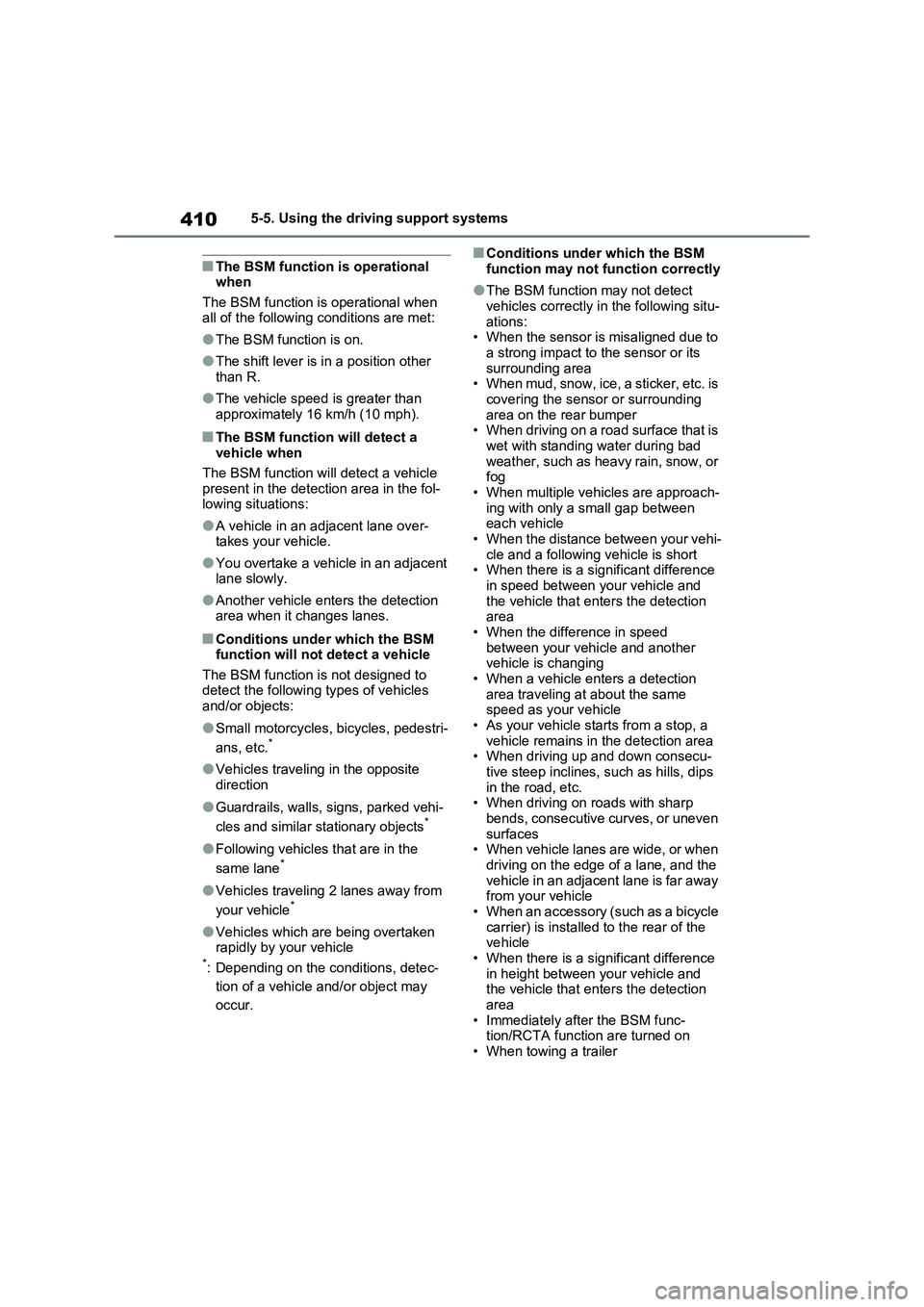
4105-5. Using the driving support systems
■The BSM function is operational
when
The BSM function is operational when
all of the following conditions are met:
●The BSM function is on.
●The shift lever is in a position other
than R.
●The vehicle speed is greater than
approximately 16 km/h (10 mph).
■The BSM function will detect a
vehicle when
The BSM function will detect a vehicle
present in the detection area in the fol-
lowing situations:
●A vehicle in an adjacent lane over-
takes your vehicle.
●You overtake a vehicle in an adjacent
lane slowly.
●Another vehicle enters the detection
area when it changes lanes.
■Conditions under which the BSM
function will not detect a vehicle
The BSM function is not designed to
detect the following types of vehicles
and/or objects:
●Small motorcycles, bicycles, pedestri-
ans, etc.*
●Vehicles traveling in the opposite
direction
●Guardrails, walls, signs, parked vehi-
cles and similar stationary objects*
●Following vehicles that are in the
same lane*
●Vehicles traveling 2 lanes away from
your vehicle*
●Vehicles which are being overtaken
rapidly by your vehicle
*: Depending on the conditions, detec-
tion of a vehicle and/or object may
occur.
■Conditions under which the BSM
function may not function correctly
●The BSM function may not detect
vehicles correctly in the following situ-
ations:
• When the sensor is misaligned due to
a strong impact to the sensor or its
surrounding area
• When mud, snow, ice, a sticker, etc. is
covering the sensor or surrounding
area on the rear bumper
• When driving on a road surface that is
wet with standing water during bad
weather, such as heavy rain, snow, or
fog
• When multiple vehicles are approach-
ing with only a small gap between
each vehicle
• When the distance between your vehi-
cle and a following vehicle is short
• When there is a significant difference
in speed between your vehicle and
the vehicle that enters the detection
area
• When the difference in speed
between your vehicle and another
vehicle is changing
• When a vehicle enters a detection
area traveling at about the same
speed as your vehicle
• As your vehicle starts from a stop, a
vehicle remains in the detection area
• When driving up and down consecu-
tive steep inclines, such as hills, dips
in the road, etc.
• When driving on roads with sharp
bends, consecutive curves, or uneven
surfaces
• When vehicle lanes are wide, or when
driving on the edge of a lane, and the
vehicle in an adjacent lane is far away
from your vehicle
• When an accessory (such as a bicycle
carrier) is installed to the rear of the
vehicle
• When there is a significant difference
in height between your vehicle and
the vehicle that enters the detection
area
• Immediately after the BSM func-
tion/RCTA function are turned on
• When towing a trailer
Trending: lumbar support, warning lights, lock, service, recommended oil, oil capacity, navigation
